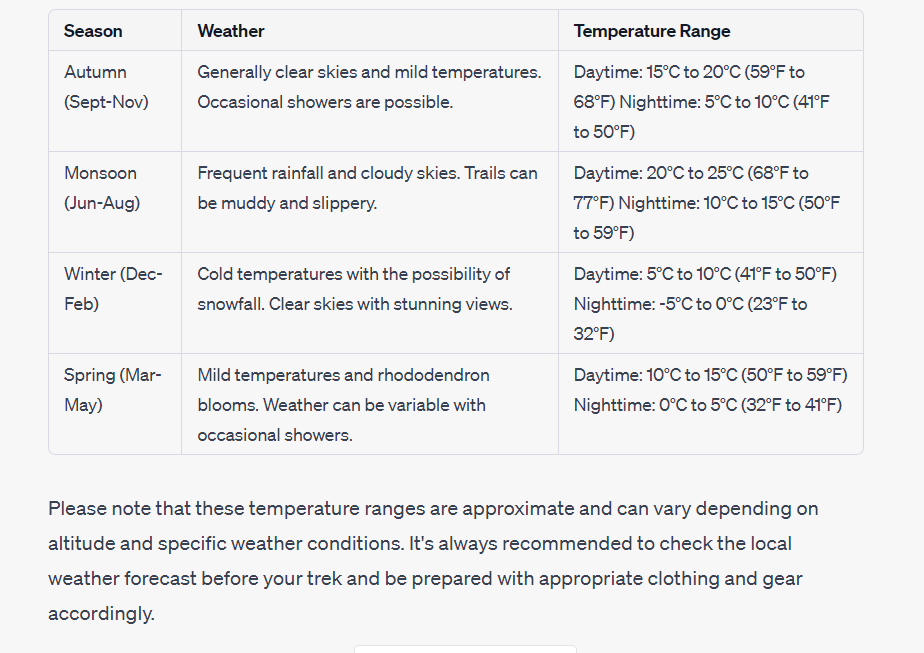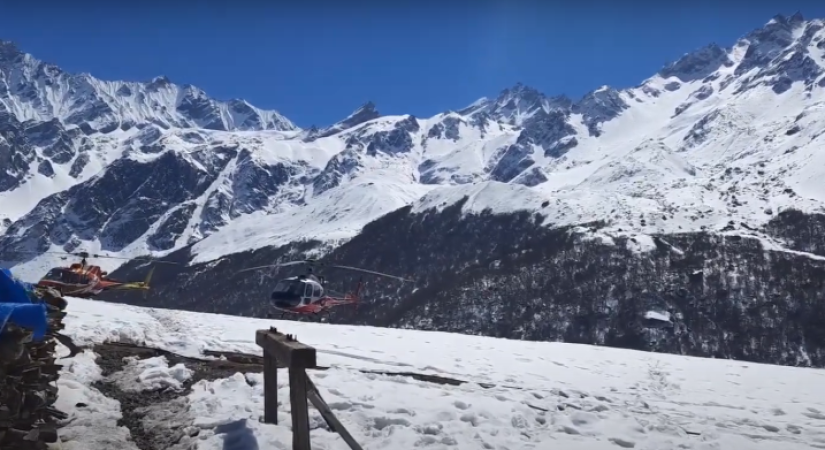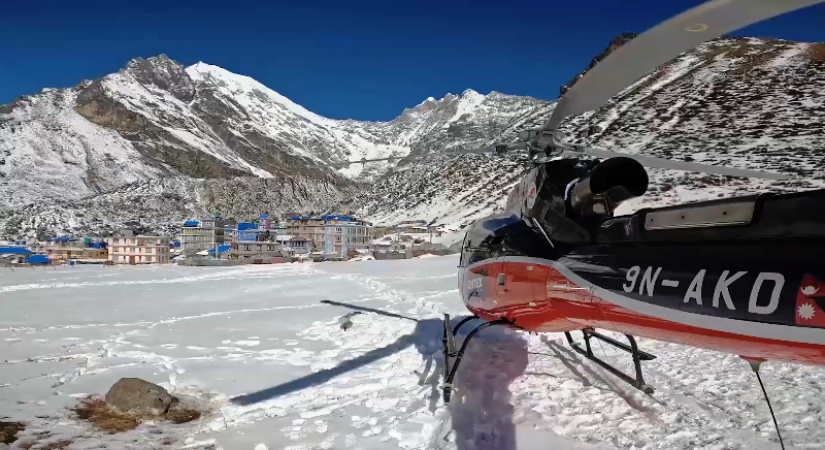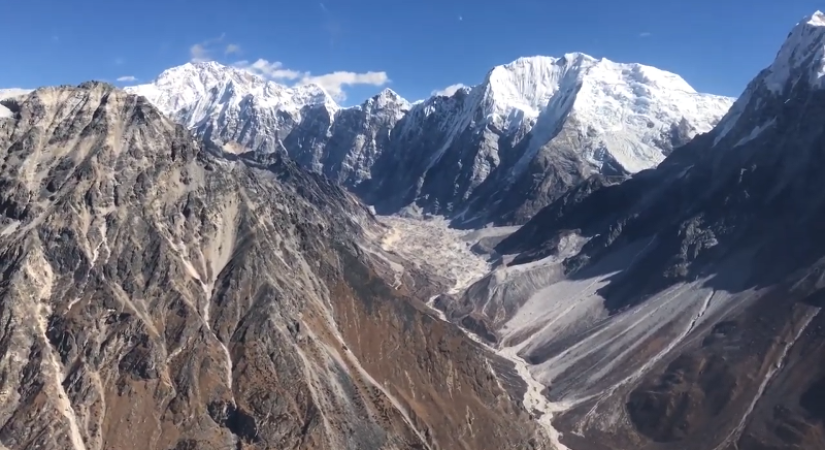KATHMANDU-SABRUBESHI-LAMA HOTEL-LANGTANG-KYANJIN GOMPA-KYANJIN -RI-HELICOPTER RETURN KTM
Why Langtang Trek with Chopper Return from Kyanjin Gompa?
- Langtang National Park, home to a variety of flora and fauna including rare species such as the red panda
- Kyanjin Gompa, a Buddhist monastery and village located at an altitude of 3,850 meters (12,635 feet)
- Tserko Ri, a peak located at an altitude of 4,984 meters (16,349 feet) offering panoramic views of the surrounding peaks and valleys
- Langtang Lirung, the highest peak in the Langtang region at an altitude of 7,227 meters (23,711 feet)
- Langtang Valley, a scenic valley with breathtaking landscapes and mountain views
- Helicopter tour of the Langtang Valley offering a bird's eye view of the region
- Thulo Syaphru, a picturesque Tamang village located on the way to Kyanjin Gompa
- Beautiful waterfalls, pristine rivers and streams, and alpine lakes such as Gosaikunda Lake
- Traditional Tamang and Sherpa culture, food, and lifestyle
- Spectacular views of the Himalayas, including peaks such as Ganesh Himal, Langtang Lirung, and Langshisa Ri.
"Langtang's beauty, Kyanjin's heights, chopper homeward flight. Adventure embraced, memories traced. Trekking thrill, nature's grace. Langtang's call, hear it all. Liftoff, memories, forever enthrall."
Trip Fact in Brief:
Location: Langtang region, Nepal
Duration: Typically 7 days
Difficulty: Moderate to challenging
Highlights: Breathtaking mountain views, diverse landscapes, unique culture
Starting Point: Syabrubesi
Trek Route: Syabrubesi - Lama Hotel - Langtang Village - Kyanjin Gompa
Altitude: Kyanjin Gompa (3,870 meters/12,697 feet)
Attractions: Langtang National Park, Langtang Valley, Langtang Lirung (7,227 meters/23,711 feet), Kyanjin Ri (4,773 meters/15,659 feet)
Accommodation: Teahouses or guesthouses along the trekking route
Permits: Langtang National Park entry permit and TIMS (Trekkers' Information Management System) card required
Best Time to Trek: Spring (March to May) and Autumn (September to November)
Weather: Varies from warm and pleasant to cold and chilly, with chances of rainfall and snowfall in higher altitudes
Safety Considerations: Adequate acclimatization, proper trekking gear, travel insurance, and following the instructions of experienced guides
Chopper Return: Option to return from Kyanjin Gompa to Kathmandu by helicopter for a quicker and more convenient journey back.
Langtang Trip Introduction
Commence on an unforgettable adventure with Nepal Everest Guide, your trusted local travel agency in Nepal. We are thrilled to offer you an extraordinary experience: the Langtang Trek with Chopper Return from Kynjin Gompa. Brace yourself for breathtaking landscapes, cultural encounters, and the convenience of a helicopter ride back to Kathmandu.
Discover the pristine beauty of the Langtang region as you embark on this exhilarating trek. Langtang Trek is renowned for its spectacular vistas of snow-capped peaks, lush forests, and serene valleys. Our experienced guides will lead you through diverse terrain, including picturesque Rhododendron forests, traditional Tamang villages, and glacial moraines. Each step brings you closer to the heart of the Himalayas, revealing its untamed grandeur.
The highlight of this trek is the chopper return from Kynjin Gompa. After reaching Kynjin Gompa, a charming village nestled in the Langtang Valley, you'll have the opportunity to experience the ultimate adventure of a helicopter ride back to Kathmandu. Soar above the majestic mountains, relishing panoramic views of the Langtang range, including the iconic Langtang Lirung, Dorje Lakpa, and Ganesh Himal. This thrilling return journey not only saves you time but also allows you to witness the awe-inspiring beauty of the Himalayas from a unique perspective.
Langtang Budget Trek with Chopper Return from Kynjin Gompa is designed for both seasoned trekkers and nature enthusiasts seeking an unforgettable experience. Our professional team ensures your safety and comfort throughout the journey, providing well-equipped accommodations and nourishing meals along the way. Immerse yourself in the rich local culture, interacting with the warm-hearted Tamang people, and gain insights into their traditional lifestyle, customs, and beliefs.
As an added bonus, this trek supports the local community's sustainable tourism initiatives. Your participation directly contributes to the economic development of the Langtang region, helping preserve its natural beauty and cultural heritage. Nepal Everest guide takes pride in promoting responsible travel practices, ensuring minimal environmental impact and maximum benefits to the local communities.
Are you ready to embark on a once-in-a-lifetime adventure? Langtang Trek with Chopper Return from Kynjin Gompa promises an unforgettable journey through the majestic Himalayas, offering breathtaking scenery, cultural immersion, and the thrill of a helicopter ride. Join us and let us make your dreams of exploring Nepal's natural wonders a reality. Book your Langtang Trek today and create memories that will last a lifetime.
Best time to go on Langatng trek and helicopter Return:
The best time to undertake the Langtang Trek with Chopper Return from Kyanjin Gompa is during the spring (March to May) and autumn (September to November) seasons. These months offer the most favorable weather conditions, with clear skies, moderate temperatures, and relatively stable trekking conditions. Spring brings blooming rhododendrons and lush greenery, while autumn offers crisp air and excellent mountain views. It's important to note that weather conditions can vary, so it's always advisable to check with local authorities or trekking agencies for the most up-to-date information before planning your trip.
How long does a chopper return from Kyanjin Gompa usually take?
The duration of a chopper return from Kyanjin Gompa can indeed vary, but on average, it takes around 30 minutes to an hour. This estimate includes factors such as helicopter availability, weather conditions, and the specific route taken by the helicopter. Keep in mind that flight times might change due to operational considerations and other variables. It's a good idea to check with the helicopter service provider for the most accurate and up-to-date information regarding the flight duration.
Weather considerations for a chopper return:
Weather considerations for a chopper return include wind conditions (crosswinds, tailwinds), visibility (fog, rain), cloud cover, precipitation (rain, snow), temperature (density altitude), turbulence, accurate weather forecasts, emergency landing options, weather radar, weight and balance. Pilot experience and training are crucial for making safe decisions based on these factors.
Langtang trek Weather and Temperature

Langtang Trek with Chopper Return from Kyanjin Gompa Outline
What's included?
- Airport transfers: Pick-up and drop-off services between the airport and hotel in Kathmandu.
- Accommodation: Comfortable hotel accommodation in Kathmandu (as per package duration) and tea houses/lodges during the trek.
- Meals: Daily breakfast in Kathmandu and full-board meals (breakfast, lunch, and dinner) during the trek.
- Transportation: Public bus transportation between Kathmandu and Syabrubesi.
- Helicopter Return: Scenic helicopter flight from Kyanjin Gompa back to Kathmandu.
- Trekking Permits: Langtang National Park permits and TIMS (Trekkers' Information Management System) card.
- Experienced Guide: Professional trekking guide with extensive knowledge of the Langtang region.
- Porters: Porters to carry your main luggage during the trek(2 trekkers: 1 Porter)
- Safety Measures: First aid kit and emergency evacuation arrangements (if required).
- Farewell Dinner after the trek.
What's not included?
- International flights: Flights to and from Kathmandu.
- Nepal Visa: The cost of obtaining a visa for Nepal.
- Travel Insurance: Comprehensive travel insurance covering trekking activities, medical emergencies, and evacuation.
- Personal Expenses: Expenses for additional meals, beverages, snacks, souvenirs, and personal equipment.
- Tips: Gratuity for guides, porters, and staff (as per your discretion).
- Additional Services: Any additional services or activities not mentioned in the package inclusions.
Day by Day Itinerary
DAY
Day 01:
Arrival in Kathmandu and transfer to the hotel.
25 Minute drive Hotel
Upon your arrival in Kathmandu, our friendly team will greet you at the airport and transfer you to your hotel. Take some rest and explore the vibrant streets of Kathmandu, soaking in the rich cultural atmosphere of the city.
DAY
02
Travel from Kathmandu to Syabrubesi (1,460 meters/4,790 feet) by public bus.
7 Hrs. Drive Breakfast, Lunch & Dinner Hotel in Sabrubeshi
After an early morning breakfast, we embark on a scenic drive from Kathmandu to Syabrubesi. Enjoy the picturesque landscapes as we make our way through lush green hills, terraced fields, and traditional Nepali settlements. Along the way, you may spot local animals like cows, goats, and chickens roaming freely in the villages.
DAY
03
Trek from Syabrubesi to Lama Hotel (2,340 meters/7,677 feet).
4-5 Hrs. Breakfast, Lunch & Dinner Lodge
Our trek officially begins as we leave Syabrubesi and start ascending through dense forests of rhododendron and bamboo. The trail offers glimpses of local wildlife such as langur monkeys, colorful birds, and perhaps even the elusive red panda. We pass by small settlements where you can observe the unique culture and lifestyle of the Tamang people. After a rewarding day of trekking, we reach Lama Hotel, a cozy stopover for the night.
DAY
Day 04:
Trek from Lama Hotel to Langtang (3,330 meters/10,925 feet).
5 Hrs. Breakfast, Lunch & Dinner Lodge
Leaving Lama Hotel, we continue our trek through the captivating Langtang Valley. The trail gradually ascends, offering mesmerizing views of the surrounding snow-capped peaks. Keep an eye out for Himalayan wildlife, including Himalayan thar, musk deer, and various bird species. We pass through charming villages like Ghoda Tabela and Thangshyap, where we can interact with the friendly locals and learn about their way of life. The rugged terrain and lush vegetation add to the allure of this picturesque trek. Upon reaching Langtang, we are greeted by panoramic mountain vistas and settle into our accommodation for the night.
DAY
05
Trek from Langtang to Kyanjing Gompa (3,730 meters/12,238 feet) for 2 to 3 hours, and after lunch, hike to Langtang.
4-5 hR Breakfast, Lunch & Dinner Lodge
Today's trek takes us to the enchanting Kyanjing Gompa, a sacred Buddhist monastery nestled amidst towering peaks. The trail offers a gentle ascent, allowing us to soak in the beauty of the surrounding landscapes. We cross wooden bridges, traverse open meadows, and pass by yaks grazing in the high-altitude pastures. Upon reaching Kyanjing Gompa, we enjoy a delicious lunch before embarking on a scenic hike to Langtang. The hike rewards us with breathtaking views of snow-capped peaks, including Langtang Lirung and Langshisha Ri. We return to Kyanjing Gompa for a well-deserved rest.
DAY
06
Exploration day at Kyanjing Ri (4,350 meters/14,271 feet) and around the Langtang Valley.
8 Hrs.. Breakfast, Lunch & Dinner Lodge
Today, we embark on an exploration of Kyanjing Ri, a viewpoint that offers jaw-dropping vistas of the Langtang range. The trail involves a steady climb, and as we ascend, the air becomes crisp and the landscapes more dramatic. From the summit of Kyanjing Ri, we are rewarded with a 360-degree panoramic view of the Langtang Valley, surrounded by majestic snow-capped peaks. We spend the day exploring the valley, visiting the local cheese factory, and immersing ourselves in the serene beauty of the surroundings.
DAY
07
Eat Breakfast and enjoy the last view then fly back to Kathmandu From Kyanjin Gompa.
20-25 Minute flight Farewell Dinner Hotel in ktm
After a hearty breakfast, we bid farewell to the mesmerizing Langtang Valley. We savor the last views of the snow-capped mountains and the tranquil surroundings before boarding a helicopter for our scenic flight back to Kathmandu. The helicopter ride provides a bird's-eye view of the stunning Himalayan landscapes and completes our Langtang Trek with a touch of adventure and luxury.
Please note that this itinerary is subject to change based on weather conditions, trail conditions, and the group's overall pace and preferences. The actual daily walking distances and timings may vary accordingly, ensuring a safe and enjoyable trekking experience.
Departure Dates
Sorry, No fixed departure dates are listed to group join, please request private trip
"Calling all adventurers! Experience the ultimate Langtang Trek and Helicopter Return at an unbeatable offer! Gather your friends and take advantage of our exclusive group discount for the upcoming season. Trek through the mesmerizing Langtang region, witness awe-inspiring mountain vistas, and immerse yourself in the unique culture. And the icing on the cake? Enjoy a swift and thrilling helicopter ride back to Kathmandu. Create lifelong memories together and save big with our special group offer. Don't miss this incredible opportunity! Contact us now to secure your discounted group booking for the Langtang Trek and Helicopter Return!"
Essential Information
Langtang Trekking Permits:
As per the latest rules effective from April 1, 2023, to undertake the Langtang Trek, you are required to join a trekking agency and have a licensed guide accompany you. If you organize your trek through Safe Holiday Adventure Pvt. Ltd, we will arrange the necessary permits for you. The cost of the TIMS card has increased to NPR 2,000 (approximately $20 USD) per person, and the Langtang National Park entry permit is priced at NPR 3,000 (approximately $30 USD) per person. It is important to stay updated with the latest regulations and consult your travel agency for accurate information regarding permits and costs.
Fitness and Training
- Fitness and training are essential for a successful Langtang Trek. Here are some tips to prepare physically and mentally:
- Cardiovascular Fitness: Engage in activities like jogging, swimming, cycling, or brisk walking to improve your cardiovascular endurance. Aim for at least 30 minutes of aerobic exercise, three to four times a week.
- Strength Training: Include exercises that target your leg muscles, such as squats, lunges, and calf raises, to build strength. Additionally, work on your core muscles with exercises like planks and sit-ups.
- Endurance Training: Gradually increase the duration and intensity of your training sessions to build endurance. Consider hiking or trekking on inclines to simulate the conditions you'll encounter during the trek.
- Stair Climbing: Incorporate stair climbing into your training routine as it mimics the uphill sections of the trek. This will help strengthen your leg muscles and prepare you for the ascent.
- Mental Preparedness: Develop mental resilience by practicing meditation, visualization, or mindfulness techniques. These can help you stay focused, motivated, and calm during challenging moments on the trek.
- Hydration and Nutrition: Maintain a balanced diet rich in carbohydrates, proteins, and healthy fats. Stay well-hydrated throughout your training and ensure you're adequately fueling your body before, during, and after exercise.
- Gradual Progression: Start your training program well in advance and gradually increase the intensity and duration of your workouts. This will help prevent injuries and allow your body to adapt to the physical demands of the trek.
Altitude Sickness
Altitude sickness, also known as acute mountain sickness (AMS), can occur when trekking at high altitudes due to the decreased oxygen levels. Here's what you need to know:
- Symptoms: Be aware of the symptoms, which can include headaches, dizziness, nausea, fatigue, shortness of breath, loss of appetite, and difficulty sleeping.
- Acclimatization: Gradual acclimatization is crucial. Take rest days during the trek to allow your body to adjust to the altitude. Ascend slowly and avoid rapid gains in elevation.
- Hydration: Drink plenty of fluids, preferably water, to stay hydrated. Avoid excessive caffeine and alcohol consumption as they can contribute to dehydration.
- Diet: Maintain a nutritious diet to fuel your body and support acclimatization. Include foods rich in carbohydrates and avoid heavy, fatty meals.
- Medications: Consult with a healthcare professional about taking acetazolamide (Diamox) as a preventive measure against altitude sickness. Carry any necessary medications for relief of symptoms.
- Descend if Necessary: If symptoms worsen or become severe, it's important to descend to a lower altitude. Do not ignore signs of altitude sickness, as it can be life-threatening if left untreated.
- Oxygen: In case of severe altitude sickness, supplemental oxygen may be required. Some trekking agencies provide portable oxygen cylinders as a precautionary measure.
- Rest and Listen to Your Body: Take breaks when needed, listen to your body, and communicate any symptoms to your trekking guide or group members. Don't push yourself beyond your limits.
- Insurance: Ensure you have travel insurance that covers emergency medical evacuation in case of severe altitude sickness or other health emergencies.
- Pre-existing Conditions: If you have pre-existing medical conditions, consult with a healthcare professional before embarking on the trek to assess your suitability and discuss any precautions or considerations.
It's crucial to educate yourself about altitude sickness, its symptoms, and preventive measures. By being prepared and taking necessary precautions, you can minimize the risk and enjoy a safe trekking experience in the Langtang region.
Accommodation
Along the Langtang Trek, you'll find a range of accommodation options to suit different budgets and preferences. Teahouses and basic lodges are the most common types of accommodation available. Teahouses offer communal dining areas and shared rooms with basic amenities like beds and blankets. Basic lodges provide slightly more comfort with private rooms and attached or shared bathrooms. Keep in mind that facilities may vary, and it's advisable to bring a sleeping bag. It's recommended to book accommodation in advance during peak trekking seasons.
Food and Water
During the Langtang Trek, you'll find a variety of food options at teahouses and lodges along the route. The menus typically offer a range of dishes, including local Nepali cuisine and international dishes like pasta, noodles, and soups. It's important to choose well-cooked and hygienic meals to avoid foodborne illnesses. Additionally, staying hydrated is crucial. Carry water purification tablets or a water filter to ensure safe drinking water, and avoid consuming untreated water from streams or taps.
Gear and Equipment
When preparing for the Langtang Trek, ensure you have the following essential gear and equipment:
- Hiking boots, Moisture-wicking socks, Thermal base layers, Insulated jacket
- Waterproof and windproof outer shell, Fleece or down jacket, Trekking pants
- Gloves and hat,Sunglasses, Sunscreen, Sleeping bag, Headlamp,Trekking poles
- Backpack, Water bottles, Snacks, First aid kit, Map and compass, Multi-tool or knife
- Trekking socks, Gaiters, Quick-dry towel,Water purification tablets,Portable charger
- Toiletries (toothbrush, toothpaste, etc.), Trekking hat or cap Neck gaiter or scarf
- Lightweight, quick-dry clothes, Trekking socks, Waterproof backpack cover
- Camera or smartphone for capturing memories, Trekking sandals or camp shoes
- Insect repellent, Trekking watch or altimeter, Emergency whistle, Cash and identification
- Duffel bag or dry bag, Trekking t-shirts, Extra batteries, Trekking socks
- Snacks and energy bars, Trekking pants, Sun hat, Trekking socks
- Trekking gloves
Communication and Internet:
While undertaking the Langtang Trek, it's important to note that mobile network coverage and internet facilities may be limited or unavailable along the trekking route. It's advisable to inform your loved ones in advance about potential communication challenges and consider carrying a satellite phone for emergencies or offline communication methods, if needed.
Safety and Emergency Procedures
Safety should be a priority during the Langtang Trek. Familiarize yourself with emergency procedures, including how to identify and respond to altitude sickness, navigate in case of getting lost, and contact emergency services. Carry a first aid kit, have travel insurance, and follow the guidance of experienced guides for a safe trekking experience.
FAQs: Langtang Trek with Chopper Return from Kyanjin Gompa
Q: What is the duration of the Langtang Trek with Chopper Return from Kyanjin Gompa package?
A: The duration of the package can vary, but typically it takes around 9 to 11 days to complete the trek.
Q: Is previous trekking experience required for the Langtang Trek?
A: Previous trekking experience is not mandatory, but it is recommended to have a basic level of fitness and stamina.
Q: How high is Kyanjin Gompa, the final destination of the trek?
A: Kyanjin Gompa is located at an elevation of 3,870 meters (12,697 feet).
Q: Are there any age restrictions for the Langtang Trek with Chopper Return package?
A: While there are no specific age restrictions, participants should be in good health and capable of walking for several hours each day.
Q: What is the best time of year to undertake the Langtang Trek?
A: The best time to go is during the spring (March to May) and autumn (September to November) when the weather is generally favorable.
Q: Is it necessary to hire a guide for the Langtang Trek?
A: Yes, it is mandatory to have a licensed guide accompany you during the Langtang Trek.
Q: What kind of helicopter is used for the chopper return from Kyanjin Gompa?
A: The type of helicopter used may vary, but generally, it will be a suitable model for mountainous terrain and safe aerial transportation.
Q: Can I customize the Langtang Trek with Chopper Return package to include additional destinations or activities?
A: Yes, many trekking agencies offer customizable packages to cater to specific preferences and interests.
Q: Are there any additional permits required for the helicopter return from Kyanjin Gompa?
A: No additional permits are required specifically for the helicopter return portion of the package.
Q: Are vegetarian and vegan food options available along the trekking route?
A: Yes, teahouses and lodges along the route offer vegetarian and vegan food options to accommodate dietary preferences.
Q: Is it possible to join a group for the Langtang Trek with Chopper Return package?
A: Yes, many trekking agencies organize group departures for this package, allowing solo travelers to join a group.
Q: What is the maximum altitude reached during the Langtang Trek?
A: The highest point of the trek is Kyanjin Ri, which stands at an elevation of approximately 4,773 meters (15,659 feet).
Q: Can I bring my own trekking gear or is it available for rent?
A: You can bring your own gear, but if needed, trekking gear can also be rented in Kathmandu or local shops near the trekking starting point.
Q: What kind of medical facilities are available along the Langtang Trek route?
A: Basic medical facilities are available at teahouses and lodges along the route, but for serious medical emergencies, evacuation by helicopter is arranged.
Q: Are there any opportunities for wildlife spotting during the trek?
A: Yes, the Langtang region is known for its diverse wildlife, including Himalayan Tahr, Red Panda, and various bird species.
Q: Can I extend my stay in Kyanjin Gompa or explore nearby areas after the trek?
A: Yes, you can choose to extend your stay in Kyanjin Gompa to explore the surrounding areas, such as the Tserko Ri viewpoint or Langtang Glacier. However, make sure to discuss the extension with your trekking agency beforehand.
Q: Are there any cultural highlights or monasteries to visit during the Langtang Trek?
A: Yes, you can visit the Kyanjin Gompa monastery, which is an important religious site for Buddhists and offers insights into the local culture and traditions.
Q: Is it safe to drink water from streams or rivers along the trekking route?
A: It is generally not recommended to drink untreated water from streams or rivers. It's advisable to use water purification tablets or a water filter to ensure safe drinking water.
Q: What happens if I need to cancel my Langtang Trek with Chopper Return booking?
A: Cancellation policies vary among trekking agencies. It's important to familiarize yourself with the terms and conditions of the agency you book with, including their cancellation and refund policies.
Q: Is there a luggage weight limit for the chopper return from Kyanjin Gompa?
A: Yes, there is usually a weight limit for luggage on the helicopter. It is typically around 10-15 kilograms (22-33 pounds) per person, including both checked and carry-on bags.
Cancellation Note
- Free cancellation up to 60 days prior departure
- 30% of the total cost of the trip will be charged if cancelled between 60 to 30 days prior to departure date
- 60% of total cost of the trip will be charged if cancelled in between 30 to 14 days prior to departure date.
Web design & Developed by Wildstone Solution








